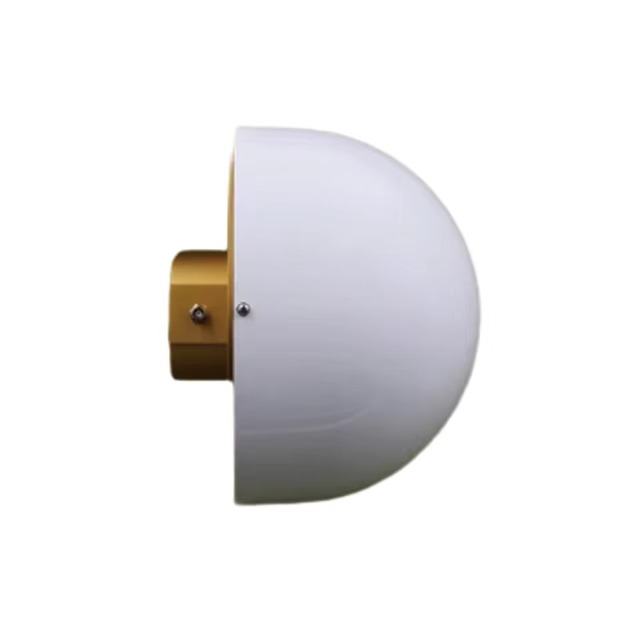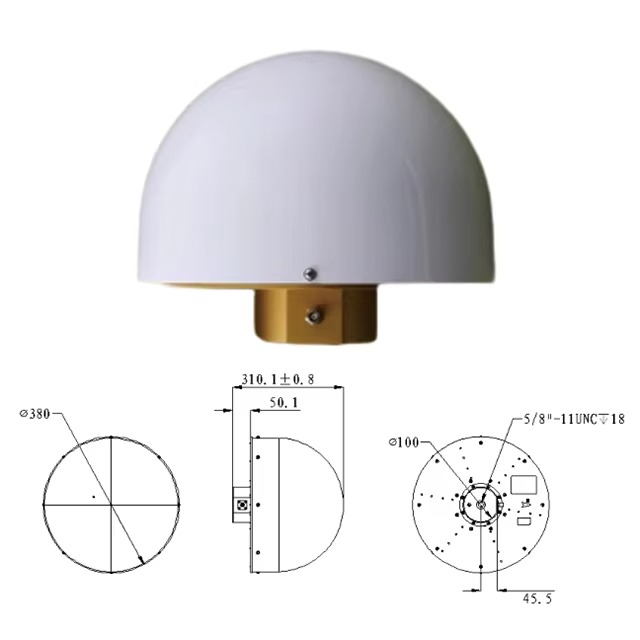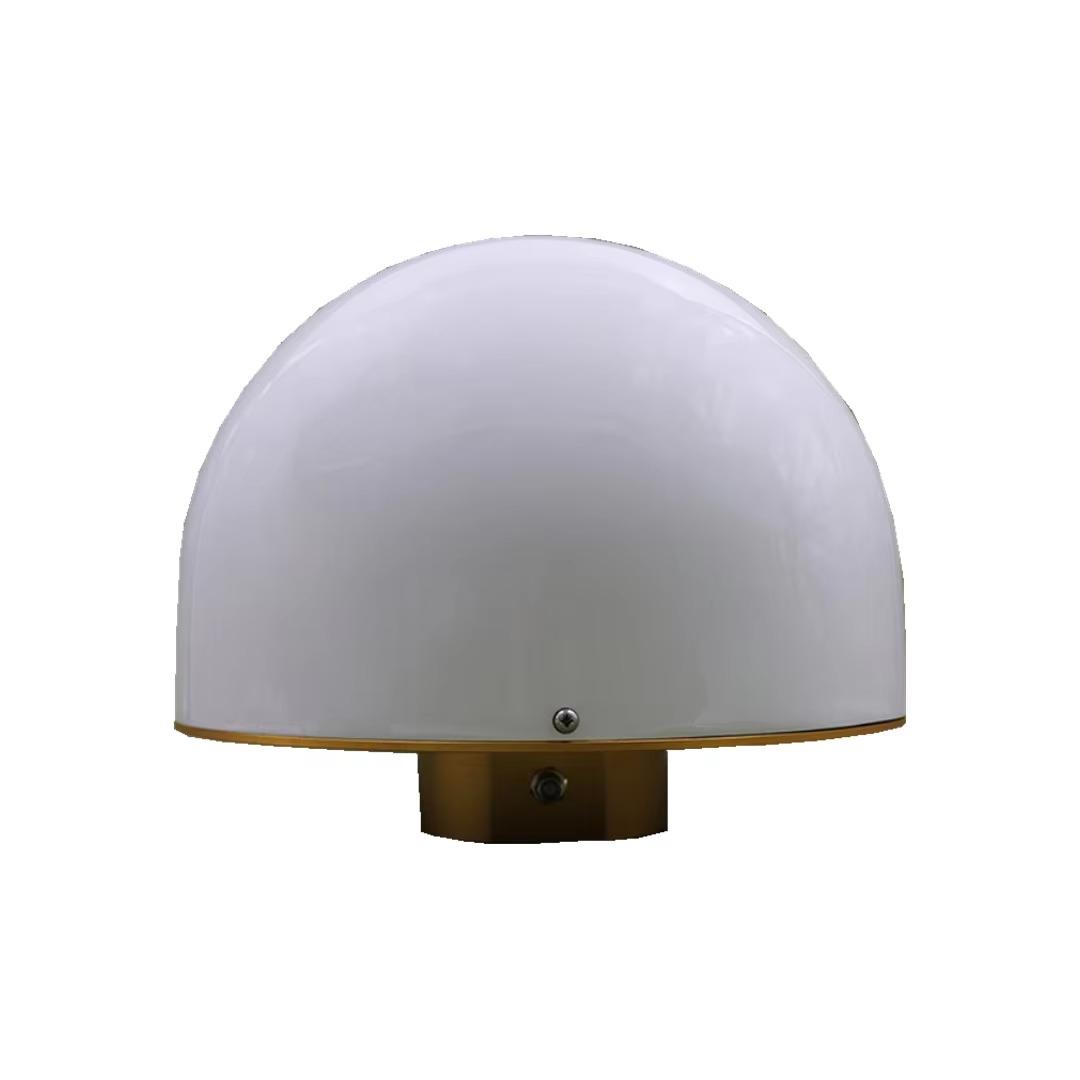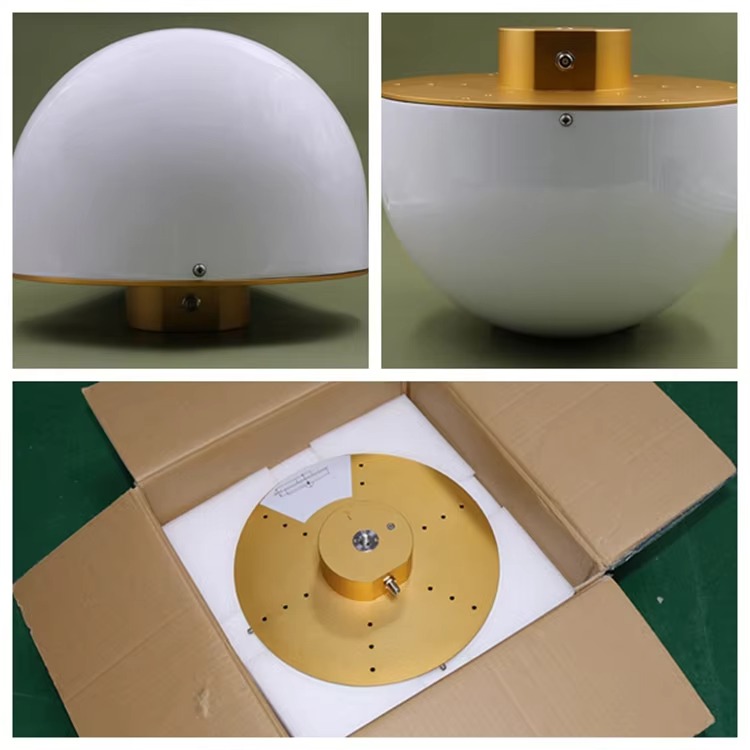GNSS relies on a constellation of satellites orbiting the Earth to transmit signals containing information about their position and time. These signals are received by antennas on the ground, which then pass the data to receivers for position calculation. However, in outdoor environments, various challenges can affect signal reception, including multipath interference, where signals reach the antenna via multiple paths after reflecting off buildings, terrain, or other objects. Multipath interference can distort the received signals and lead to significant errors in positioning calculations.
The choke ring antenna is specifically designed to mitigate multipath interference, making it highly suitable for outdoor RTK applications. The “choke ring” refers to a distinctive physical structure integrated into the antenna design. This structure consists of a series of concentric rings or grooves around the antenna element, which act as a form of signal filtering. By carefully manipulating the electromagnetic fields around the antenna, the choke ring reduces the impact of reflected signals, allowing the antenna to predominantly receive the direct signals from satellites. This results in a cleaner and more accurate signal input for the RTK system, enabling precise positioning even in complex outdoor environments with high potential for multipath interference.
Outdoor RTK choke ring GNSS antennas are widely deployed in applications where accuracy is non - negotiable. In land surveying, they enable surveyors to create highly detailed and accurate maps, measure property boundaries with precision, and monitor land deformation over time. In the automotive industry, especially for autonomous driving, these antennas ensure that vehicles can accurately determine their position on the road, which is crucial for functions like lane - keeping, collision avoidance, and precise navigation. In the aerospace sector, they support aircraft navigation, approach guidance, and satellite tracking with high reliability. As the demand for reliable and accurate outdoor positioning continues to grow across multiple industries, the role of outdoor RTK choke ring GNSS antennas is becoming increasingly vital.
The design and construction of an outdoor RTK choke ring GNSS antenna involve a combination of advanced electromagnetic theory, precise mechanical engineering, and high - quality material selection to achieve optimal performance in mitigating multipath interference and enhancing signal reception.
Antenna Element Design
At the core of the outdoor RTK choke ring GNSS antenna is the antenna element, which is responsible for capturing the weak GNSS signals from satellites. Microstrip antenna elements are commonly used due to their compact size and efficient performance in the GNSS frequency bands. A microstrip antenna typically consists of a metallic patch, often made of copper or gold, placed on a dielectric substrate with a ground plane beneath.
The design of the metallic patch is optimized through electromagnetic simulations to resonate at the specific frequencies of GNSS signals, such as the L1 (1.575 GHz), L2 (1.227 GHz), and L5 (1.176 GHz) bands for GPS. These simulations help engineers fine - tune the shape, size, and configuration of the patch to achieve high gain, good impedance matching, and a suitable radiation pattern. High gain ensures that the antenna can effectively capture weak satellite signals, while proper impedance matching minimizes signal reflections, improving the overall efficiency of signal reception.
The dielectric substrate is carefully selected for its electrical properties, such as dielectric constant and loss tangent. Substrates with a stable dielectric constant over a wide range of temperatures and environmental conditions are preferred to ensure consistent performance. Materials like ceramic - based substrates are popular choices due to their high dielectric constant, which allows for miniaturization, and their excellent thermal and mechanical stability.
Choke Ring Structure
The most distinctive feature of the antenna is the choke ring structure, which is designed to combat multipath interference. The choke ring typically consists of a series of concentric metallic rings or grooves arranged around the antenna element. These rings or grooves are precisely engineered to interact with the electromagnetic fields of the incoming GNSS signals.
The principle behind the choke ring's operation is based on the manipulation of surface waves. When a GNSS signal reaches the antenna, both direct and reflected signals are present. The choke ring structure is designed to suppress the propagation of surface waves associated with the reflected signals. By creating a specific electromagnetic environment around the antenna element, the choke ring causes the reflected signals to be either absorbed or redirected, while allowing the direct signals to pass through with minimal interference.
The dimensions and spacing of the rings or grooves in the choke ring are critical parameters. These are determined through extensive simulations and testing to optimize the antenna's performance in different operating conditions. The height, width, and number of rings are carefully calculated to ensure that the antenna can effectively reject multipath signals across the relevant GNSS frequency bands.
Enclosure and Mounting
Outdoor RTK choke ring GNSS antennas are designed to withstand harsh outdoor environments. The enclosure is typically made from durable materials such as aluminum alloy or high - strength engineering plastics. Aluminum alloy enclosures offer excellent mechanical strength, electromagnetic shielding, and heat dissipation properties, making them suitable for applications where the antenna may be exposed to physical impacts, electromagnetic interference, or high - temperature conditions. Engineering plastic enclosures, on the other hand, are lightweight, corrosion - resistant, and provide good protection against moisture and UV radiation.
The enclosure is designed with weatherproof seals and gaskets to prevent water and dust ingress. O - rings are commonly used around openings such as connectors and mounting holes to create a watertight barrier. The enclosure may also feature a sloped or curved surface to facilitate the runoff of water, reducing the chance of water pooling on the antenna.
For mounting, these antennas often come with a variety of options to suit different applications. They can be mounted on tripods, masts, rooftops, or vehicle surfaces. The mounting mechanism is designed to provide a stable and secure installation, ensuring that the antenna remains in place even in the face of strong winds, vibrations, or other mechanical disturbances. Some antennas may feature adjustable mounts, allowing users to optimize the antenna's orientation for the best signal reception.
Electrical Components and Assembly
Inside the enclosure, the antenna houses electrical components such as a low - noise amplifier (LNA) and associated circuitry. The LNA is a crucial component that amplifies the weak GNSS signals received by the antenna element while adding minimal noise. It is carefully selected for its high gain, low noise figure, and wide bandwidth to ensure effective amplification of the GNSS signals within the required frequency range.
The electrical components are assembled on a printed circuit board (PCB) with careful consideration given to signal routing, impedance matching, and electromagnetic compatibility. The PCB layout is designed to minimize electromagnetic interference (EMI) and ensure proper signal integrity. Shielding techniques may be employed to protect the sensitive electrical components from external EMI sources.
Before final assembly, the antenna undergoes rigorous testing to ensure that it meets the required performance standards. This includes testing for signal reception, multipath rejection, gain, and impedance matching. Only after passing these tests is the antenna ready for deployment in the field.
The working principles of an outdoor RTK choke ring GNSS antenna revolve around the processes of signal reception, multipath mitigation, amplification, and transmission to the RTK receiver, all of which work together to enable accurate positioning in outdoor environments.
Signal Reception
The operation of the antenna begins with the antenna element capturing the weak radio - frequency signals transmitted by GNSS satellites. These signals, carrying information about the satellite's position and time, travel through the Earth's atmosphere and reach the antenna. The antenna element, with its optimized design, efficiently couples with the incoming signals and converts the electromagnetic energy of the signals into electrical signals.
When the frequency of the incoming GNSS signals matches the resonant frequency of the antenna element, a resonance effect occurs. This resonance enhances the antenna's ability to absorb the energy of the signals, generating electrical currents that represent the received signals. However, in outdoor environments, these initial signals are often accompanied by multipath signals that have been reflected off various objects in the surroundings.
Multipath Mitigation
This is where the choke ring structure plays a crucial role. As the direct and reflected signals reach the antenna, the choke ring interacts with the electromagnetic fields of these signals. The concentric rings or grooves in the choke ring are designed to manipulate the surface waves associated with the reflected signals.
For reflected signals, the choke ring structure causes the surface waves to experience a phase shift or attenuation. This effectively suppresses the propagation of these waves towards the antenna element. In contrast, the direct signals from the satellites, which approach the antenna at a more direct angle, are less affected by the choke ring. The direct signals are able to pass through the choke ring structure with minimal interference and reach the antenna element, where they are properly received and processed.
By reducing the impact of multipath signals, the choke ring ensures that the antenna predominantly receives the direct signals from the satellites. This results in a cleaner and more accurate signal input, which is essential for high - precision positioning using the RTK system.
Signal Amplification and Transmission
The weak electrical signals received by the antenna element, now predominantly direct signals thanks to the multipath mitigation by the choke ring, are then fed into a low - noise amplifier (LNA). The LNA amplifies these signals while keeping the added noise to a minimum. The amplified signals are then passed through a series of filters to remove any remaining unwanted frequencies or interference.
The filtered and amplified signals are transmitted from the antenna to the RTK receiver via a coaxial cable or other suitable transmission medium. The RTK receiver uses these signals, along with correction data from reference stations, to calculate the precise position of the antenna (and thus the device it is attached to) on Earth's surface. The accurate and clean signals provided by the outdoor RTK choke ring GNSS antenna, combined with the RTK correction data, enable the receiver to achieve centimeter - level or even millimeter - level positioning accuracy.
-
Advantages
One of the most significant advantages of outdoor RTK choke ring GNSS antennas is their exceptional ability to mitigate multipath interference. In outdoor environments where multipath signals are common, especially in urban areas with tall buildings or in mountainous regions with complex terrain, these antennas can significantly reduce positioning errors caused by reflected signals. This makes them ideal for applications that demand high - precision positioning, such as surveying, where even small errors can have a significant impact on the accuracy of maps and property boundary measurements.
The high - precision positioning enabled by these antennas also benefits industries like autonomous driving. In self - driving vehicles, accurate positioning is crucial for safe operation, and the ability of the choke ring antenna to provide clean and reliable signals ensures that the vehicle can precisely determine its position on the road, identify lane markings, and navigate complex traffic scenarios.
Outdoor RTK choke ring GNSS antennas are also known for their durability. Their robust enclosure and construction materials allow them to withstand harsh outdoor conditions, including extreme temperatures, heavy rain, snow, and strong winds. This durability ensures long - term reliable operation, reducing the need for frequent maintenance or replacement, which is especially important for applications in remote or hard - to - access locations.
Another advantage is their compatibility with multiple GNSS constellations. These antennas are designed to receive signals from various satellite systems, such as GPS, GLONASS, Galileo, and BeiDou. This multi - constellation capability provides greater redundancy and improved signal availability, enhancing the overall reliability of the positioning system.
Challenges
Despite their many advantages, outdoor RTK choke ring GNSS antennas face several challenges. One of the primary challenges is their size and weight. The choke ring structure adds to the physical dimensions and weight of the antenna, which can be a limitation in applications where space is limited or where a lightweight solution is required. For example, in some unmanned aerial vehicle (UAV) applications, the size and weight of the antenna may impact the flight performance and payload capacity of the UAV.
Cost is also a significant factor. The design and construction of these antennas, which involve advanced electromagnetic engineering, precise manufacturing of the choke ring structure, and high - quality materials, result in a relatively high production cost. This cost can be a barrier for some applications, especially those with budget constraints, limiting their widespread adoption in certain markets.
Installation and alignment of outdoor RTK choke ring GNSS antennas can be complex. Proper installation is crucial for optimal performance, and ensuring the correct orientation of the antenna to maximize signal reception requires careful calibration. In some cases, specialized equipment and trained personnel may be needed for installation, adding to the overall complexity and cost of deployment.
Electromagnetic interference (EMI) remains a challenge. Although the antenna's enclosure is designed to provide some shielding against EMI, in environments with high levels of electromagnetic noise, such as near communication towers or industrial facilities, the antenna's performance may still be affected. Additional shielding or interference mitigation measures may be required, which can further increase the complexity and cost of the installation.
-
Applications
Outdoor RTK choke ring GNSS antennas have a wide range of applications across multiple industries. In the surveying and mapping industry, they are the preferred choice for creating high - accuracy maps. Surveyors use these antennas to measure positions with centimeter - level precision, which is essential for land development, construction projects, and cadastral surveys. The accurate data collected by these antennas helps in determining property boundaries, monitoring land subsidence, and creating detailed topographic maps.
In the automotive industry, especially in the development of autonomous driving systems, these antennas play a vital role. They enable vehicles to accurately determine their position on the road, which is necessary for features such as lane - keeping assist, adaptive cruise control, and autonomous navigation. The ability to mitigate multipath interference ensures that the vehicle's positioning system remains reliable even in urban environments with tall buildings that can cause signal reflections.
In the aerospace industry, outdoor RTK choke ring GNSS antennas are used for aircraft navigation, approach guidance, and satellite tracking. They help pilots determine the aircraft's position accurately, especially during critical phases such as takeoff and landing. For satellite tracking, these antennas provide the precise positioning data needed to monitor and control satellites in orbit.
These antennas are also used in the marine industry for ship navigation. They enable vessels to navigate safely in coastal areas and open seas, even in challenging weather conditions. The high - precision positioning provided by the antennas helps ships avoid hazards, follow accurate routes, and dock safely.
Future Trends
Looking ahead, several future trends are expected to shape the development of outdoor RTK choke ring GNSS antennas. One trend is the further miniaturization of these antennas. As technology advances, new materials and manufacturing techniques will be explored to reduce the size and weight of the choke ring structure without sacrificing its multipath mitigation performance. This miniaturization will enable the antennas to be used in a wider range of applications, including smaller UAVs, wearable devices, and compact surveying equipment.
The integration of artificial intelligence (AI) and machine learning (ML) algorithms with outdoor RTK choke ring GNSS antennas is an emerging trend. AI and ML can be used to optimize the antenna's performance in real - time. These algorithms can analyze the received signals, detect changes in the signal environment, and adjust the antenna's operation parameters, such as gain and filtering, to adapt to different conditions. For example, AI can be used to dynamically adjust the antenna's response to changing multipath conditions, further enhancing its interference - mitigation capabilities.
Advancements in communication technologies will also impact these antennas. The development of 5G and other high - speed, low - latency communication networks will enable faster and more reliable transmission of RTK correction data. This will improve the overall performance of the RTK system, allowing for even more accurate positioning. Outdoor RTK choke ring GNSS antennas will need to be designed to take full advantage of these new communication technologies.
There is also a growing trend towards the development of multi - functional antennas. Future outdoor RTK choke ring GNSS antennas may integrate additional functions, such as weather sensing or wireless communication capabilities. This integration will reduce the number of antennas required on a device, saving space and potentially reducing costs.
Conclusion
In conclusion, outdoor RTK choke ring GNSS antennas are essential components for achieving high - precision positioning in outdoor environments. Their unique design, with the choke ring structure for multipath mitigation, enables them to provide accurate and reliable signals, which are crucial for applications in surveying, automotive, aerospace, marine, and other industries.
However, challenges such as size, cost, installation complexity, and electromagnetic interference need to be addressed. Overcoming these challenges will require continuous innovation in design, materials, and manufacturing processes, as well as the adoption of emerging technologies.
As the demand for high - precision positioning continues to grow across various sectors, the future of outdoor RTK choke ring GNSS antennas looks promising. With trends such as miniaturization, the integration of AI and ML, advancements in communication technologies, and the development of multi - functional antennas, these antennas will continue to evolve and play an even more significant role in enabling accurate and reliable outdoor positioning. They will contribute to the development of more efficient, safe, and intelligent systems in multiple industries, driving technological progress and innovation.




































































 Language
Language
 En
En Cn
Cn Korean
Korean

 Home >
Home > 








 18665803017 (Macro)
18665803017 (Macro)













